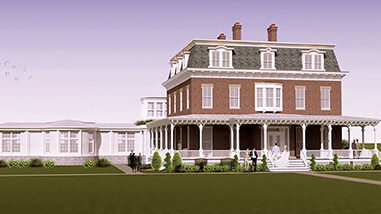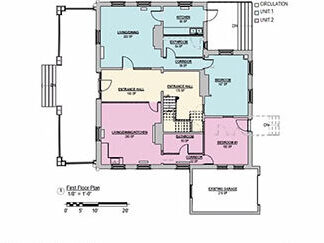
By Sunayana Prabhu
FORT HANCOCK – At the latest meeting of the Fort Hancock 21st Century Federal Advisory Committee (FACA), Roy Stillman, president of Stillman Development International, unveiled new floor plans for two Officers Row buildings.
The possibility of affordable housing garnered support at the public meeting, however some public commenters equated the leasing program to “privatization,” a designation met with resistance from FACA members whose intention is to preserve the historic structures through redevelopment.
At the virtual open public meeting Oct. 19, FACA members, along with Jennifer Nersesian, National Park Service (NPS) superintendent, reviewed the latest updates to the ongoing Fort Hancock redevelopment plans and welcomed public comment.
Out of 21 Officers Row buildings located on Fort Hancock, Stillman selected buildings 7 and 12 – lieutenant and commander quarters, respectively – as prototypes to show floor plans for how the buildings would be renovated into either four or five apartment units per building. The total number of apartments across all buildings would range from the “upper 70s to the mid 80s, depending on whether you’d have four or five per building,” Stillman said.
The buildings were chosen as representative samples to show layout, materials and design characteristics.
From front porches to fireplace mantels, garages to stair landings, “urgent intervention” was needed, Stillman said, describing the ongoing deterioration as “poor and accelerating in a negative direction by virtue mostly of water infiltration and the freeze and fall cycle.”
While he expressed his preference for offering affordable housing, Stillman emphasized that, from an economic perspective, there is a revenue impact. He said there will be subsidy requirements in order to achieve affordable housing, “but we are wide open to the discussion of expanding the concept of public good, whether it be for veterans, for economic, affordable housing characteristics for other segments of the population.”
According to Nersesian, affordable housing has long been the recommendation of the advisory committee and also of interest to the public. However, trying to create more access to these opportunities for different income brackets and segments of the population calls for a business model, Nersesian said, “that needs subsidies and partnerships, and we still have work to do chasing down leads to see if this is feasible.”
Daphne Yun, public affairs specialist for Gateway National Recreation Area, provided The Two River Times with an updated breakdown of the leasing activity of buildings at Fort Hancock.
Currently leased buildings include: Barracks (Building 23) and Mess Hall (Building 56) will be used by the Marine Academy of Science and Technology; Post (Building 53) being used as a café; buildings 21 and 52 currently utilized for lodging; Building 104 is dedicated office space; and Building 36, the Mule Barn, is operating as a bar.
Under a Letter of Intent (a tentative agreement between the government and a potential leaseholder for building use, which includes preliminary requirements to be completed within a stated timeframe), buildings 24 and 25 are proposed for residential use. The Officers Club (Building 114) is a proposed event space.
The Officers Club has been vacant since 1981. At the meeting, Stillman also proposed designs to preserve the important features and rehabilitate the building back to its 1900s roots.

The NPS has a general agreement with Stillman on the rest of the 23 buildings.
Bennett Brooks, facilitator for FACA meetings, transcribed the meeting live. The committee proposed NPS further explore the viability of the project to accommodate a mix of affordable, senior and veteran housing. Following public arguments over “privatization,” Brooks added member feedback to the report, urging “NPS to address any misconceptions related to leasing activity equaling privatization.”
“Privatization is the ‘P’ word which should not be used,” James Krauss, FACA committee member, said. “This is not privatization. This is a leasing program.”
Public commenters pushed back at NPS and FACA members insisting on the term “leasing program.” One of the attendees who remained anonymous wrote in the online chat window during the meeting, “Can you please make the distinction clear – how is this program not privatization?” The same attendee also asked, “How would ‘privatization’ differ from this program of leasing space to private developers, business owners and residents? Are there goals in place to, for example, promote minority-owned businesses?”
Nersesian clarified that the program does not take anything away that the public currently has access to. “Right now, the public cannot get inside the buildings – they are too deteriorated and not safe. By bringing in private investment to rehabilitate them, they will create a restored historic landscape for everyone to enjoy,” said Nersesian.
She further explained that there will still be full access to the grounds around the buildings. “The ownership stays with the government. We have representative structures like the History House on Officers Row that continue to give people access to what they look like on the inside,” she said, without the additional investment the buildings will eventually fall down and “we all lose that piece of our national heritage.”
The attendee further argued, “I think it’s still very fair for the public to call it “privatization,” in that it precludes any potential scheme of public access for the term of the lease and destroys historic interior fabric in support of private use and private profit-taking. It remains possible to allow time to take its course and allow most of the buildings not preserved as museums to deteriorate naturally. That’s also a cultural process that offers access to history, and one many buildings onsite are already undergoing. Managed deterioration doesn’t mean a loss of heritage.”
Nersesian clarified that while the NPS appreciates a variety of perspectives on this, “under these projects it is not just the exteriors that are preserved; the interiors are still beholden to the Secretary of Interior Standards for Historic Preservation.”
The article originally appeared in the October 27 – November 2, 2022 print edition of The Two River Times.














